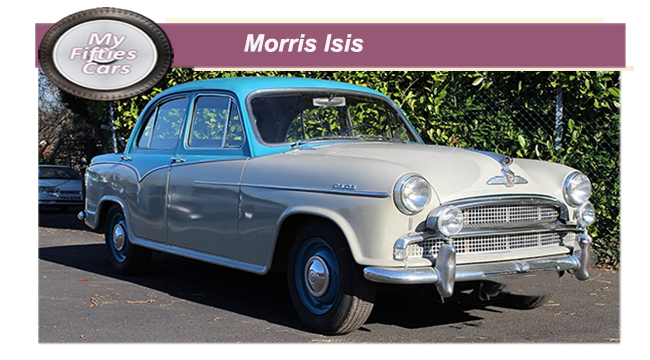
Yet another example of BMC's standardisation policy, the six-cylinder Morris Isis introduced in July 1955 was a more upmarket version of the Oxford saloon.
The main difference was that the Isis was fitted with Austin's C-series 1639cc (161 cu in) six-cylinder engine.
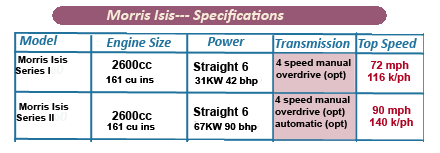 The C-series engine had already appeared in the Austin Westminster, with the only change in the Morris application was the adoption of a SU rather than Zenith carburettor.
The C-series engine had already appeared in the Austin Westminster, with the only change in the Morris application was the adoption of a SU rather than Zenith carburettor.
In July 1955 the range was expanded with the addition of the Isis.
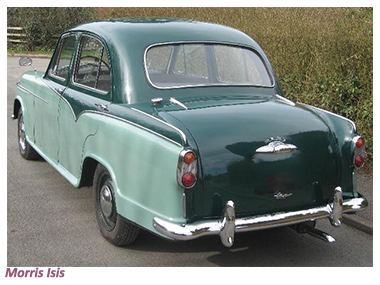 Available as both a saloon and Traveller, the Isis was virtually identical with the Oxford from the windscreen rearwards, with a lengthened front end structure which, in the opinion of many in the motoring media of those days, gave the car a rather ungainly appearance when viewed from certain angles.
Available as both a saloon and Traveller, the Isis was virtually identical with the Oxford from the windscreen rearwards, with a lengthened front end structure which, in the opinion of many in the motoring media of those days, gave the car a rather ungainly appearance when viewed from certain angles.
 While much of the bodywork of the Morris Isis was identical to both the Oxford and the Cowley, the Isis had been fitted with a sporty looking mesh backing to its front grille (actually introduced a few weeks earlier), which quickly distinguished it from the Oxford when viewed head-on.
While much of the bodywork of the Morris Isis was identical to both the Oxford and the Cowley, the Isis had been fitted with a sporty looking mesh backing to its front grille (actually introduced a few weeks earlier), which quickly distinguished it from the Oxford when viewed head-on.
To give the impression of luxury, the Isis was fitted with a more sumptuous interior that included glove boxes on each side of a restyled instrument panel, and re-positioned switchgear which could now be more easily reached by the driver.
![]()
A full-width padded fascia top and a deeply-dished safety steering wheel were also introduced.
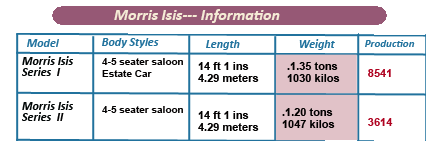 Whilst the Isis’s performance was reasonable, the general impression from drivers was that the car suffered badly because of its clumsy handling, a factor which did not help sales figures.
As was becoming general procedure at BMC, when the Oxford was restyled in 1956, the Isis followed suit, with its engine being tuned to provide a higher compression ratio taking power up to 67kW (90bhp).
Whilst the Isis’s performance was reasonable, the general impression from drivers was that the car suffered badly because of its clumsy handling, a factor which did not help sales figures.
As was becoming general procedure at BMC, when the Oxford was restyled in 1956, the Isis followed suit, with its engine being tuned to provide a higher compression ratio taking power up to 67kW (90bhp).
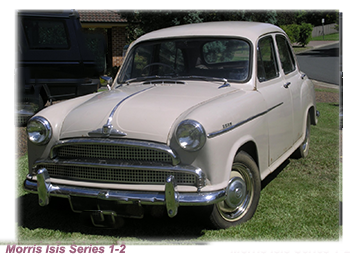 The six-cylinder engine in the Isis was also updated, an increase in the compression ratio raised the power output from 86bhp to 90bhp.
The six-cylinder engine in the Isis was also updated, an increase in the compression ratio raised the power output from 86bhp to 90bhp.
 The Isis was originally fitted with a column gearchange that was not well received.
Described as dated with a floor-mounted arrangement - unusual, the lever was positioned to the right of the driver's seat.
Borg Warner overdrive had been available on the Isis since its introduction, while a fully automatic gearbox from the same source was now available as an optional extra.
The Isis was originally fitted with a column gearchange that was not well received.
Described as dated with a floor-mounted arrangement - unusual, the lever was positioned to the right of the driver's seat.
Borg Warner overdrive had been available on the Isis since its introduction, while a fully automatic gearbox from the same source was now available as an optional extra.
![]()
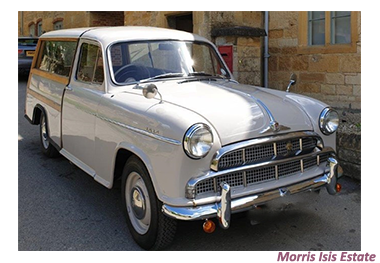 Early in 1957 attractive two-tone paint schemes were introduced on both the Oxford and Isis models, with the colour division being highlighted by new chromium plated moulding.
Early in 1957 attractive two-tone paint schemes were introduced on both the Oxford and Isis models, with the colour division being highlighted by new chromium plated moulding.
Another major update came in September of the same year when the rather angular Traveller bodywork gave way to a two door estate car completely re-styled rear end. The wooden trim was still in evidence, looking a lot more symmetricak in the two door format
 Ultimately, although it remained in production for the three years between 1955 until 1958 the Isis was no more successful than its predecessor, the Six, had been, although it had a much more distinguished look.
Ultimately, although it remained in production for the three years between 1955 until 1958 the Isis was no more successful than its predecessor, the Six, had been, although it had a much more distinguished look.
Carrying the distinction of being the only 'Morris' model to be fitted with the C-Series engine, the Isis was finally discontinued with its possible only accolade being that BMC made no attempt to replace the model.


